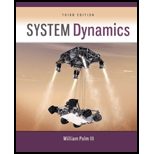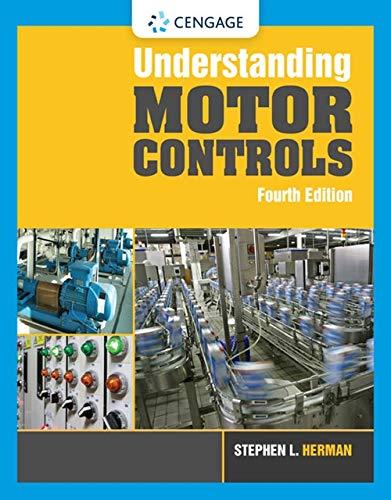
System Dynamics
3rd Edition
ISBN: 9780073398068
Author: III William J. Palm
Publisher: MCG
expand_more
expand_more
format_list_bulleted
Concept explainers
Textbook Question
Chapter 10, Problem 10.66P
Consider Example 10.6.3. Modify the diagram in Figure 10.6.2 to show an actuator transfer function T(s)/M(s) = 1/(0.lx + 1). Use the same gain values computed for the three cases in that example.
- Use MATLAB to plot the command response and the actuator response to a unit-step command. Identify the peak actuator values for each case.
- Use MATLAB to plot the disturbance frequency response.
- Compare the results in parts (a) and (b) with those of Example 10.6.3.
Expert Solution & Answer
Want to see the full answer?
Check out a sample textbook solution
Students have asked these similar questions
H.w 2: The open loop response, that is, the speed of the motor to a voltage input of 20V, assuming a
system without damping is
dw
20 = (0.02) + (0.06)w.
dt
If the initial speed is zero (w(0) = 0) ,and using the Runge-Kutta 4th order method, what is the speed at
t = 0.8s? Assume a step size of h = 0.4s.
QUESTION 3
An open loop transfer function with a unitary feedback control system is given
K
by G(s) =-
where K is the gain of the system. An open loop
(s+1)(s+4)
transfer function with a PID controller must be designed in order to yield a
peak time of 1.047 s, and a damping ratio of 0.8.
3.1. Calculate the design point s, of the system
3.2.
Calculate the gain and the zero(s) of the PID controller
3.3.
Provide the block diagram of the compensated system with the PID
controller
Q5) For unity feedback control system with forward transfer function (G(s) ):
G(s) =
; By using root locus graph calculate the value
K(s+5)
(s+2)(s²+12s+50)
of gain (K) which must be added to get the dominant root at damping ratio
(-0.886) and natural frequency (w = 8 rad/sec )?
www
CTRICAL
ENGIN
Chapter 10 Solutions
System Dynamics
Ch. 10 - Prob. 10.1PCh. 10 - 10.2 Draw the block diagram of a system using...Ch. 10 - Prob. 10.3PCh. 10 - Prob. 10.4PCh. 10 - Prob. 10.5PCh. 10 - Prob. 10.8PCh. 10 - Prob. 10.9PCh. 10 - Prob. 10.12PCh. 10 - Prob. 10.13PCh. 10 - Prob. 10.14P
Ch. 10 - Prob. 10.15PCh. 10 - Prob. 10.16PCh. 10 - Prob. 10.17PCh. 10 - Prob. 10.19PCh. 10 - Prob. 10.20PCh. 10 - Prob. 10.21PCh. 10 - Prob. 10.22PCh. 10 - Prob. 10.23PCh. 10 - Prob. 10.24PCh. 10 - Consider the PI speed control system shown in...Ch. 10 - Prob. 10.26PCh. 10 - Prob. 10.27PCh. 10 - Prob. 10.28PCh. 10 - Prob. 10.29PCh. 10 - Prob. 10.30PCh. 10 - Prob. 10.31PCh. 10 - Prob. 10.32PCh. 10 - Prob. 10.33PCh. 10 - Prob. 10.34PCh. 10 - Prob. 10.35PCh. 10 - Prob. 10.36PCh. 10 - For the designs found in part (a) of Problem...Ch. 10 - Prob. 10.39PCh. 10 - Prob. 10.40PCh. 10 - Prob. 10.41PCh. 10 - Prob. 10.44PCh. 10 - Prob. 10.45PCh. 10 - Prob. 10.46PCh. 10 - For the system shown in Figure 10.7.1, / = c = 1....Ch. 10 - Prob. 10.48PCh. 10 - Prob. 10.51PCh. 10 - Prob. 10.52PCh. 10 - Prob. 10.53PCh. 10 - Prob. 10.54PCh. 10 - Prob. 10.56PCh. 10 - Prob. 10.57PCh. 10 - Prob. 10.58PCh. 10 - Prob. 10.59PCh. 10 - Prob. 10.60PCh. 10 - Prob. 10.61PCh. 10 - Prob. 10.62PCh. 10 - Prob. 10.63PCh. 10 - Prob. 10.64PCh. 10 - Prob. 10.65PCh. 10 - Consider Example 10.6.3. Modify the diagram in...Ch. 10 - Prob. 10.67PCh. 10 - 10.68 Consider Example 10.6.4. Modify the diagram...Ch. 10 - 10.69 Figure P10.7 shows a system for controlling...Ch. 10 - A speed control system using an...Ch. 10 - Prob. 10.72PCh. 10 - Prob. 10.73PCh. 10 - Prob. 10.74PCh. 10 - Consider Example 10.7.4. Use the diagram in Figure...Ch. 10 - Prob. 10.76PCh. 10 - Refer to Figure 10.3.9, which show s a speed...Ch. 10 - For the system in Problem 10.77 part (a), create a...
Knowledge Booster
Learn more about
Need a deep-dive on the concept behind this application? Look no further. Learn more about this topic, mechanical-engineering and related others by exploring similar questions and additional content below.Similar questions
- The open loop transfer function for a control system is given as follows. 4K G(s) = s(s+2) For this system, it is desired to design a forward phase (LEAD) compensator. With the use of this controller, the static speed error coefficient is 20, the phase margin is at least 50 degrees and the gain margin is at least 10 dB. Design this controller.arrow_forwardThe satallite system below is controlled using reaction wheels. The torque wheel input for the system is u(s) and the satallite attitude is Ө(s) For a strong communication link Ө needs to be a value where the satallite atenna is pointing at the ground station The transfer function for this system will be shown in the picture. Design a feedback control system that sets the closed loop damping ratio at 0.8 and the natural frequency is at 10 rad/sec.arrow_forwardGraph/Plot the output step response from t=0 to t=10 with a 0.1-second interval.arrow_forward
- consider the system The suitable compensator for this system that meets the following specifications: Overshoot less than or equal to 20% and speed gain (Kv) greater than or equal to 10 is: choose an alternative A: B: C: D: None of the alternativesarrow_forward1.block diagram physical meaning and the time response for different inputsarrow_forwardFigure 1 shows an electrical system comprising a series RLC circuit and input voltagesource ein(t).(a) Derive the input-output equation with output y = I and input u = ein(t). (b) Using the derived input-output equation, drive the system transfer function G(s)that relates output to input. Use the following numerical values for the electrical systemparameters: resistance R = 2Ω, inductance L = 0.25H, and capacitance C = 0.4F. (c) Using the derived transfer function, derive the time-domain ordinary differentialequation for the input-output equation of this electrical system. (d) Draw the complete block diagram of this series RLC circuit using the derived transferfunction.arrow_forward
- Find the equivalent transfer function of the negative feedback system of figure below: R(s) C(s) G(s) H(s) G(s) K and H(s) =1 s(s +2)? find two values of gain that will yield closed-loop, overdamped, second-order poles. Repeat for underdamped poles find the value of gain, K, that will make the system critically damped. find the value of gain, K, that will make the system marginally stable. Also, find the frequency of oscillation at that value of K that makes the system marginally stable.arrow_forwardDevelop MATLAB code to model Qacm with a fixed outlet temp of T= 870K. Optimizing componentsarrow_forward1) Determine the steady-state (forced) response and the time constant (or dominant time constant) for each of these systems: a. x+ 2x = 0 with x(0) = 10 b. 4x + 8x + 40x = 20 with x(0) = 0 and x(0) = 0 10x + 4x = 24 with x(0) = 0 C. d. *+ 34x + 64x = 8 with x(0) = 0 and x(0) = 0arrow_forward
- A mobile robot using a vision system as the measurement device is shown in the figure below. The control system is shown in figure (b). Design the controller so that (a) the percent overshoot for a step input is P.O. < 5 (b) the settling time (with a 2% criterion) is Ts < 6s (c) the system velocity error constant Kv < 0.9 (d) the peak time, TP, for a step input is minimized. Motion subsystem B Object environment Recognition subsystem Computerarrow_forwardPlease refer to the instruction below. As7 A42 A76 x, Aer A43 A54 A65 A32 X, A45 A s0 A23 A34 A72 Fig. 8-34 Identify the (a) input node, (b) output node, (c) forward paths, (d) feedback paths, (e) self-loop. Determine the (f) loop gains of the feedback loops, (g) path gains of the forward paths.arrow_forwardThe armature current of a de machine is controlled with a feedback loop. The following is known about the machine: KPWM = 12 (PWM converter gain) Te = 16 ms (electrical time constant) R = 2.0 2 (Armature resistance) %3D Assuming a PI controller that cancels the electrical time constant is used, what is the proportional time constant in terms of the integral time constant (Kp)? KI 16m K (16m K + 1) 1 16m 1) KI \1500arrow_forward
arrow_back_ios
SEE MORE QUESTIONS
arrow_forward_ios
Recommended textbooks for you
 Understanding Motor ControlsMechanical EngineeringISBN:9781337798686Author:Stephen L. HermanPublisher:Delmar Cengage Learning
Understanding Motor ControlsMechanical EngineeringISBN:9781337798686Author:Stephen L. HermanPublisher:Delmar Cengage Learning

Understanding Motor Controls
Mechanical Engineering
ISBN:9781337798686
Author:Stephen L. Herman
Publisher:Delmar Cengage Learning
What is Metrology in Mechanical Engineering? | Terminologies & Measurement; Author: GaugeHow;https://www.youtube.com/watch?v=_KhMhFRehy8;License: Standard YouTube License, CC-BY